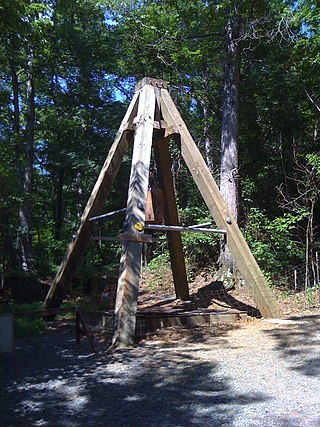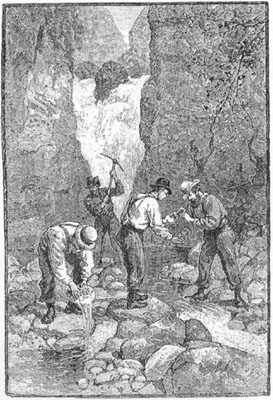Related Research Articles

The California gold rush (1848–1855) began on January 24, 1848, when gold was found by James W. Marshall at Sutter's Mill in Coloma, California. The news of gold brought approximately 300,000 people to California from the rest of the United States and abroad. The sudden influx of gold into the money supply reinvigorated the American economy; the sudden population increase allowed California to go rapidly to statehood in the Compromise of 1850. The gold rush had severe effects on Native Californians and accelerated the Native American population's decline from disease, starvation, and the California genocide.

Mariposa is an unincorporated community and census-designated place (CDP) in and the county seat of Mariposa County, California, United States. The population was 1,526 at the 2020 census. Named for the monarch butterflies that overwinter there, the community's history is deeply intertwined with the California Gold Rush of the 19th century.

A gold rush or gold fever is a discovery of gold—sometimes accompanied by other precious metals and rare-earth minerals—that brings an onrush of miners seeking their fortune. Major gold rushes took place in the 19th century in Australia, Greece, New Zealand, Brazil, Chile, South Africa, the United States, and Canada while smaller gold rushes took place elsewhere.

Placer mining is the mining of stream bed deposits for minerals. This may be done by open-pit mining or by various surface excavating equipment or tunneling equipment.

The Reed Gold Mine is located in Midland, Cabarrus County, North Carolina, and is the site of the first documented commercial gold find in the United States. It has been designated a National Historic Landmark because of its importance and listed on the National Register of Historic Places

The Gold Country is a historic region in the northern portion of the U.S. state of California, that is primarily on the western slope of the Sierra Nevada. It is famed for the mineral deposits and gold mines that attracted waves of immigrants, known as the 49ers, during the 1849 California Gold Rush.

A gold nugget is a naturally occurring piece of native gold. Watercourses often concentrate nuggets and finer gold in placers. Nuggets are recovered by placer mining, but they are also found in residual deposits where the gold-bearing veins or lodes are weathered. Nuggets are also found in the tailings piles of previous mining operations, especially those left by gold mining dredges.

The California State Mining and Mineral Museum exhibits and interprets the state's mineral resources and mining heritage. It is part of the California state park system, and is located near Mariposa, a town in central California, on the premises of the Mariposa County fairgrounds.

Gold mining is the extraction of gold by mining.

George Frederick Kunz was an American mineralogist and mineral collector.

The Hand of Faith is a gold nugget of fine-quality that was found by Kevin Hillier using a metal detector near Kingower, Victoria, Australia on 26 September 1980. Weighing 875 troy ounces, the gold nugget was only 12 inches (30 cm) below the surface, resting in a vertical position. The announcement of the discovery occurred at a press conference, attended by Premier of Victoria Dick Hamer, in Melbourne on 8 October 1980. Kovac's Gems & Minerals was appointed as the agent for the sale of the huge nugget by Hillier. It was sold to the Golden Nugget Casino chain for over a million dollars.

Pala is a small, mostly Native American community and census-designated place located within the Pala Indian Reservation in San Diego County, California. For centuries a traditional gathering place of native peoples. The Mission San Antonio de Pala or Pala Mission was established in Pala by early 19th century as an asistencia or sub-mission.

The Georgia Gold Rush was the second significant gold rush in the United States and the first in Georgia, and overshadowed the previous rush in North Carolina. It started in 1829 in present-day Lumpkin County near the county seat, Dahlonega, and soon spread through the North Georgia mountains, following the Georgia Gold Belt. By the early 1840s, gold became difficult to find. Many Georgia miners moved west when gold was found in the Sierra Nevada in 1848, starting the California Gold Rush. Since the 16th century, American Indians in Georgia told European explorers that the small amounts of gold which they possessed came from mountains of the interior. Some poorly documented accounts exist of Spanish or French mining gold in North Georgia between 1560 and 1690, but they are based on supposition and on rumors passed on by Indians. In summing up known sources, W.S. Yeates observed: "Many of these accounts and traditions seem to be quite plausible. Nevertheless, it is hardly probable that the Spaniards would have abandoned mines which were afterwards found to be quite profitable, as those in North Georgia."

In the United States, gold mining has taken place continually since the discovery of gold at the Reed farm in North Carolina in 1799. The first documented occurrence of gold was in Virginia in 1782. Some minor gold production took place in North Carolina as early as 1793, but created no excitement. The discovery on the Reed farm in 1799 which was identified as gold in 1802 and subsequently mined marked the first commercial production.

The Leadville mining district, located in the Colorado Mineral Belt, was the most productive silver-mining district in the state of Colorado and hosts one of the largest lead-zinc-silver deposits in the world. Oro City, an early Colorado gold placer mining town located about a mile east of Leadville in California Gulch, was the location to one of the richest placer gold strikes in Colorado, with estimated gold production of 120,000–150,000 ozt, worth $2.5 to $3 million at the then-price of $20.67 per troy ounce.

Ironstone’s Crown Jewel is the world’s largest piece of crystalline gold. At 44 lbs troy (16.4 kg), it is substantially larger than the Fricot "Nugget" and the Whopper, the next two largest specimens.
Mining in the United States has been active since the beginning of colonial times, but became a major industry in the 19th century with a number of new mineral discoveries causing a series of mining rushes. In 2015, the value of coal, metals, and industrial minerals mined in the United States was US$109.6 billion. 158,000 workers were directly employed by the mining industry.

Gold mining in Western Australia is the third largest commodity sector in Western Australia (WA), behind iron ore and LNG, with a value of A$17 billion in 2021–22. The 6.9 million troy ounces sold during this time period was the highest amount in 20 years and accounted for almost 70 percent of all gold sold in Australia.

Yogo sapphires are blue sapphires, a colored variety of corundum, found in Montana, primarily in Yogo Gulch in Judith Basin County, Montana. Yogo sapphires are typically cornflower blue, a result of trace amounts of iron and titanium. They have high uniform clarity and maintain their brilliance under artificial light. Because Yogo sapphires occur within a vertically dipping resistive igneous dike, mining efforts have been sporadic and rarely profitable. It is estimated that at least 28 million carats of Yogo sapphires are still in the ground. Jewelry containing Yogo sapphires was given to First Ladies Florence Harding and Bess Truman; in addition, many gems were sold in Europe, though promoters' claims that Yogo sapphires are in the crown jewels of England or the engagement ring of Princess Diana are dubious. Today, several Yogo sapphires are part of the Smithsonian Institution's gem collection.
References
- 1 2 "The Fricot Gold Nugget from California". Gold Rush Nuggets.
- 1 2 "fricot nugget". The Georgetown Divide. 25 January 2009.
- ↑ "California State Mining and Mineral Museum". California State Parks.
- ↑ Nuggets, Rare Gold (September 23, 2015). "These 3 Huge Gold Nuggets Were Found in California".
- ↑ "Four arrested in hijacking of gold and gems from mariposa museum". Los Angeles Times . 15 November 2012.
- ↑ "Thieves armed with pickaxes take $2 million in gems, gold from Calif. museum, officials say". CBS News . 2 October 2012.